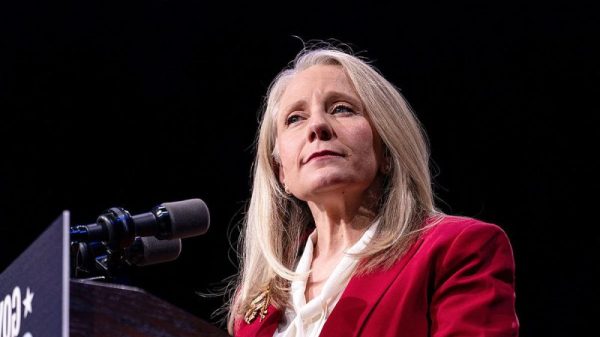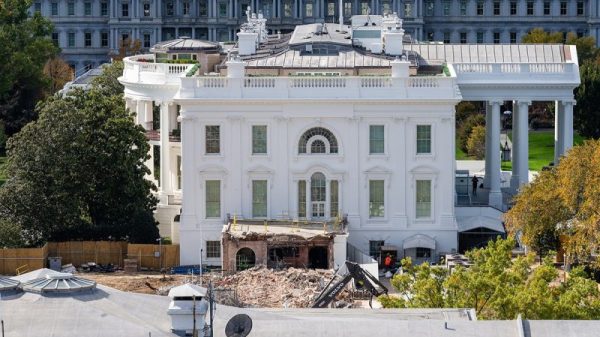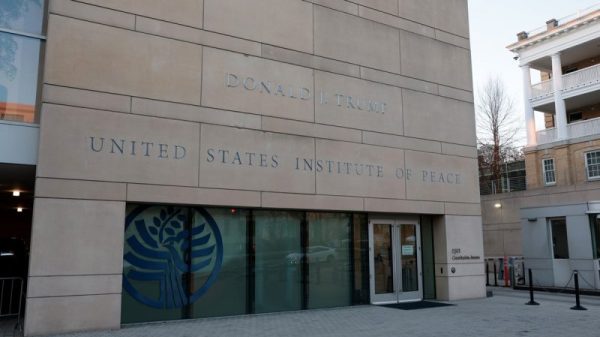NEW YORK — The courthouse’s 15th floor is available for only one trial.
All judges except New York Supreme Court Justice Juan Merchan must work elsewhere for now. An organization that intervenes in the lives of youths caught up in the justice system has relocated temporarily to spaces off-site.
Those and other special conditions are in place at the Manhattan courthouse where Donald Trump’s criminal trial began this week, the first prosecution of a former U.S. president. The trial and the related unusual adjustments may last six to eight weeks.
So far, the scene in and around 100 Centre Street, the main criminal courts building, has been a spectacle, to say the least.
Security has consumed the area with pedestrian and traffic blockades. On Monday, a MAGA rally and hordes of reporters occupied the park across the street where court employees have lunch on nice days.
In that same park Friday, a man set himself on fire in what police believe was a political statement that did not appear to be directly connected to the trial. He was hospitalized in critical condition.
Court officers and police teams in tactical gear descended on the street, and pedestrians were blocked from a main courthouse entryway.
Many attorneys and others dread the roadblocks and extra hassle that can accompany big courthouse events and make it harder for anyone to get to where they need to go.
“Whenever anything big is in the courthouse, it’s annoying,” said defense lawyer Norman Williams, who is not involved in the Trump case.
Anyone attending the trial must be screened at the main entrances in the lobby and on the 15th floor by New York state court officers, who are responsible for securing the courthouse and areas around it. Surrounding the building is a maze of metal barricades, generating confusion over what areas are accessible.
The New York Police Department, which has specialized units that respond to demonstrations and other major events, has a large presence of officers with additional units on call nearby. The Secret Service protection is for Trump.
Manhattan District Attorney Alvin Bragg charged Trump with 34 counts of falsifying business records in connection with $130,000 paid to adult-film actress Stormy Daniels near the end of the 2016 presidential campaign to keep her quiet about an alleged sexual encounter with him, while he was married, years earlier. Trump pleaded not guilty.
Jury selection began Monday and continued Tuesday, when seven jurors were sworn in. Court was not in session Wednesday but resumed Thursday and, after some adjustments, ended that day with a 12-member jury and one alternate selected. Jury selection concluded Friday with five more alternates picked, and opening statements were scheduled for Monday.
Through the years, other cases at the courthouse have drawn major attention, though none with the same national historical significance as this one.
In early 2020, prominent film producer Harvey Weinstein was tried and convicted of sexual assaults. In late 2022, Trump’s company was convicted of tax fraud. Actor Alec Baldwin had an assault case over a parking dispute that resulted in a plea deal in 2019, and actor Jonathan Majors was convicted in December in his domestic violence case.
A group of Black and Latino teenagers who became known as the “Central Park Five” were convicted in the same court — in a building across the street — and were later exonerated in connection to the 1989 rape of a female jogger, a case that heightened tensions about crime and discrimination in the nation. (Trump at the time bought newspaper advertisements saying the state of New York should adopt the death penalty.)
The defendants served time before being legally cleared of wrongdoing in 2002, when a DNA test linked a convicted sex offender to the attack. Their civil rights lawsuit was settled with the city paying $41 million.
Another case, the abduction and murder of 6-year-old Etan Patz in 1979 — which vexed detectives for decades — had a dramatic conclusion at the courthouse with the 2017 conviction of a former deli clerk who confessed to the crime.
One case in particular comes to mind for some courthouse veterans: the 2011 arrest and aborted prosecution of former International Monetary Fund head Dominique Strauss-Kahn.
Strauss-Kahn was poised to possibly be the next president of France when he was pulled from a plane by police at Kennedy International Airport and arrested on charges that he sexually assaulted a hotel maid in Manhattan.
Benjamin Brafman, Strauss-Kahn’s lawyer, said none of his other cases involving high-profile defendants generated the scene that Strauss-Kahn caused when he was at the courthouse for a handful of appearances, before his case was dismissed for lack of proof and he was allowed to return to France.
“I was stunned by the number of media personnel that were actually out in front of the building,” Brafman said, adding that it was “impossible to navigate” the surrounding streets.
Another of Brafman’s cases that took place in the courthouse across the street — where several criminal judges on New York’s Supreme Court also sit — involved the 1999 arrest of the performer and business executive Sean Combs, who has used other names during his career, such as Diddy and Puff Daddy, after a melee broke out at Club New York. Combs was acquitted of gun possession and bribery charges in 2001 after a trial that drew many of his fans and news professionals to the proceeding and outside the courthouse.
Recently, search warrants were executed at Combs’s homes in Los Angeles and Miami in connection with a federal investigation, and he has been sued by women alleging sexual abuse and sex trafficking.
The 17-story Art Deco courthouse at 100 Centre Street, which includes a two-story marble lobby, was built between 1938 and 1941 and has been featured in movies and TV dramas. Tourists often wander into the building, even for night court arraignments that can be slow-moving and mundane throughout the evening until 1 a.m.
The building, commonly called the Manhattan Criminal Courthouse, is home to the Criminal Court, which handles misdemeanors and some other violations, and the New York County Supreme Court, Criminal Term, where felony cases like Trump’s are brought. (Some criminal courtrooms are in a mixed-use building at 111 Centre Street.)
The structure is every bit its age in decor and functionality, as Trump and prospective jurors learned this past week when they were hit with an early spring chill that court staff could not seem to control with the heating system.
Merchan said even a minor adjustment in the 15th-floor courtroom could make it too warm and uncomfortable. On Friday, he said someone was working on trying to make it less chilly.
Trump’s case involves a payment to Daniels, whose real name is Stephanie Clifford, made by his former lawyer and fixer Michael Cohen. In addition to Daniels, former Playboy model Karen McDougal, who was also paid to keep silent about an alleged affair, is expected to testify, possibly along with members of Trump’s administration and a former National Enquirer executive who allegedly engaged in efforts to prevent bad publicity about Trump.
Retired judge Charles Solomon, who oversaw the Combs trial, said Merchan’s most important priority in the Trump case will be to protect the integrity of the jury process. At the Combs trial, Solomon said, he staggered the arrival times for jurors and others involved in the case to avoid any contact between them and to avoid having them face a steady flow of the defendant’s fans.
“I made a point of making sure there was no contact,” Solomon said.
He also said a beefed-up staff of court officers is important. “You have to have more officers in the courtroom,” Solomon said, adding that any unhinged person “could just run up and punch Trump in the head” if there isn’t an adequate security buffer between people involved in the case and observers.
A woman who worked at a separate courthouse in Queens was at Trump’s civil trial on Oct. 18 and tried to rush the aisle to speak to him in the middle of testimony. She was intercepted by court officers and arrested.
Merchan has ruled that juror names will not be made public. In court, they are being identified by the numbers they are assigned.
Since Trump’s indictment last year, he and his team have entered the courthouse through the Manhattan district attorney’s office. They use a nonpublic elevator to the 15th floor, where he can discreetly get to the courtroom.
Bragg recently wrote to his staff about protocols for employees and visitors. “I want to assure you that we will do everything in our power to support you during this time and to ensure that your work continues as uninterrupted as possible,” he wrote.
Al Baker, spokesman for New York state court system, said in a statement that the building “will remain fully open to serve the public in every respect.”
“Our court officers, judges, and non-judicial personnel fully understand and appreciate their role in keeping our Manhattan Criminal Courts operating smoothly, no matter the nature or scope of the proceedings ongoing,” Baker said. “They work collaboratively, every single day, to ensure that access to meaningful justice remains a constant for everyone.”
NYPD Assistant Chief James N. McCarthy, commanding officer of Patrol Borough Manhattan South, said the court’s perimeter would have ample coverage and there would be many resources on standby.
“Within minutes, we’ll have a large contingent to help out with whatever is needed in crowd control,” McCarthy said, adding that there will be “frozen zones” at times to pause entry to the area.
NYPD Assistant Chief of Intelligence John Hart said the response plan was similar to how the department handled crowds that gathered in the city after the 2016 election “in terms of the amount of resources and the amount of attention.”
His division is also monitoring for threats, and while there haven’t been any related specifically to the trial, “it wouldn’t shock me that people are going to attempt to do things,” Hart said.
“We will see a clear uptick aimed probably toward DA Bragg and in general toward the jury,” Hart said. “Our main goal is just to get to the source of the threat to make sure everybody’s safe.”
NEW YORK — The courthouse’s 15th floor is available for only one trial.
All judges except New York Supreme Court Justice Juan Merchan must work elsewhere for now. An organization that intervenes in the lives of youths caught up in the justice system has relocated temporarily to spaces off-site.
Those and other special conditions are in place at the Manhattan courthouse where Donald Trump’s criminal trial began this week, the first prosecution of a former U.S. president. The trial and the related unusual adjustments may last six to eight weeks.
So far, the scene in and around 100 Centre Street, the main criminal courts building, has been a spectacle, to say the least.
Security has consumed the area with pedestrian and traffic blockades. On Monday, a MAGA rally and hordes of reporters occupied the park across the street where court employees have lunch on nice days.
In that same park Friday, a man set himself on fire in what police believe was a political statement that did not appear to be directly connected to the trial. He was hospitalized in critical condition.
Court officers and police teams in tactical gear descended on the street, and pedestrians were blocked from a main courthouse entryway.
Many attorneys and others dread the roadblocks and extra hassle that can accompany big courthouse events and make it harder for anyone to get to where they need to go.
“Whenever anything big is in the courthouse, it’s annoying,” said defense lawyer Norman Williams, who is not involved in the Trump case.
Anyone attending the trial must be screened at the main entrances in the lobby and on the 15th floor by New York state court officers, who are responsible for securing the courthouse and areas around it. Surrounding the building is a maze of metal barricades, generating confusion over what areas are accessible.
The New York Police Department, which has specialized units that respond to demonstrations and other major events, has a large presence of officers with additional units on call nearby. The Secret Service protection is for Trump.
Manhattan District Attorney Alvin Bragg charged Trump with 34 counts of falsifying business records in connection with $130,000 paid to adult-film actress Stormy Daniels near the end of the 2016 presidential campaign to keep her quiet about an alleged sexual encounter with him, while he was married, years earlier. Trump pleaded not guilty.
Jury selection began Monday and continued Tuesday, when seven jurors were sworn in. Court was not in session Wednesday but resumed Thursday and, after some adjustments, ended that day with a 12-member jury and one alternate selected. Jury selection concluded Friday with five more alternates picked, and opening statements were scheduled for Monday.
Through the years, other cases at the courthouse have drawn major attention, though none with the same national historical significance as this one.
In early 2020, prominent film producer Harvey Weinstein was tried and convicted of sexual assaults. In late 2022, Trump’s company was convicted of tax fraud. Actor Alec Baldwin had an assault case over a parking dispute that resulted in a plea deal in 2019, and actor Jonathan Majors was convicted in December in his domestic violence case.
A group of Black and Latino teenagers who became known as the “Central Park Five” were convicted in the same court — in a building across the street — and were later exonerated in connection to the 1989 rape of a female jogger, a case that heightened tensions about crime and discrimination in the nation. (Trump at the time bought newspaper advertisements saying the state of New York should adopt the death penalty.)
The defendants served time before being legally cleared of wrongdoing in 2002, when a DNA test linked a convicted sex offender to the attack. Their civil rights lawsuit was settled with the city paying $41 million.
Another case, the abduction and murder of 6-year-old Etan Patz in 1979 — which vexed detectives for decades — had a dramatic conclusion at the courthouse with the 2017 conviction of a former deli clerk who confessed to the crime.
One case in particular comes to mind for some courthouse veterans: the 2011 arrest and aborted prosecution of former International Monetary Fund head Dominique Strauss-Kahn.
Strauss-Kahn was poised to possibly be the next president of France when he was pulled from a plane by police at Kennedy International Airport and arrested on charges that he sexually assaulted a hotel maid in Manhattan.
Benjamin Brafman, Strauss-Kahn’s lawyer, said none of his other cases involving high-profile defendants generated the scene that Strauss-Kahn caused when he was at the courthouse for a handful of appearances, before his case was dismissed for lack of proof and he was allowed to return to France.
“I was stunned by the number of media personnel that were actually out in front of the building,” Brafman said, adding that it was “impossible to navigate” the surrounding streets.
Another of Brafman’s cases that took place in the courthouse across the street — where several criminal judges on New York’s Supreme Court also sit — involved the 1999 arrest of the performer and business executive Sean Combs, who has used other names during his career, such as Diddy and Puff Daddy, after a melee broke out at Club New York. Combs was acquitted of gun possession and bribery charges in 2001 after a trial that drew many of his fans and news professionals to the proceeding and outside the courthouse.
Recently, search warrants were executed at Combs’s homes in Los Angeles and Miami in connection with a federal investigation, and he has been sued by women alleging sexual abuse and sex trafficking.
The 17-story Art Deco courthouse at 100 Centre Street, which includes a two-story marble lobby, was built between 1938 and 1941 and has been featured in movies and TV dramas. Tourists often wander into the building, even for night court arraignments that can be slow-moving and mundane throughout the evening until 1 a.m.
The building, commonly called the Manhattan Criminal Courthouse, is home to the Criminal Court, which handles misdemeanors and some other violations, and the New York County Supreme Court, Criminal Term, where felony cases like Trump’s are brought. (Some criminal courtrooms are in a mixed-use building at 111 Centre Street.)
The structure is every bit its age in decor and functionality, as Trump and prospective jurors learned this past week when they were hit with an early spring chill that court staff could not seem to control with the heating system.
Merchan said even a minor adjustment in the 15th-floor courtroom could make it too warm and uncomfortable. On Friday, he said someone was working on trying to make it less chilly.
Trump’s case involves a payment to Daniels, whose real name is Stephanie Clifford, made by his former lawyer and fixer Michael Cohen. In addition to Daniels, former Playboy model Karen McDougal, who was also paid to keep silent about an alleged affair, is expected to testify, possibly along with members of Trump’s administration and a former National Enquirer executive who allegedly engaged in efforts to prevent bad publicity about Trump.
Retired judge Charles Solomon, who oversaw the Combs trial, said Merchan’s most important priority in the Trump case will be to protect the integrity of the jury process. At the Combs trial, Solomon said, he staggered the arrival times for jurors and others involved in the case to avoid any contact between them and to avoid having them face a steady flow of the defendant’s fans.
“I made a point of making sure there was no contact,” Solomon said.
He also said a beefed-up staff of court officers is important. “You have to have more officers in the courtroom,” Solomon said, adding that any unhinged person “could just run up and punch Trump in the head” if there isn’t an adequate security buffer between people involved in the case and observers.
A woman who worked at a separate courthouse in Queens was at Trump’s civil trial on Oct. 18 and tried to rush the aisle to speak to him in the middle of testimony. She was intercepted by court officers and arrested.
Merchan has ruled that juror names will not be made public. In court, they are being identified by the numbers they are assigned.
Since Trump’s indictment last year, he and his team have entered the courthouse through the Manhattan district attorney’s office. They use a nonpublic elevator to the 15th floor, where he can discreetly get to the courtroom.
Bragg recently wrote to his staff about protocols for employees and visitors. “I want to assure you that we will do everything in our power to support you during this time and to ensure that your work continues as uninterrupted as possible,” he wrote.
Al Baker, spokesman for New York state court system, said in a statement that the building “will remain fully open to serve the public in every respect.”
“Our court officers, judges, and non-judicial personnel fully understand and appreciate their role in keeping our Manhattan Criminal Courts operating smoothly, no matter the nature or scope of the proceedings ongoing,” Baker said. “They work collaboratively, every single day, to ensure that access to meaningful justice remains a constant for everyone.”
NYPD Assistant Chief James N. McCarthy, commanding officer of Patrol Borough Manhattan South, said the court’s perimeter would have ample coverage and there would be many resources on standby.
“Within minutes, we’ll have a large contingent to help out with whatever is needed in crowd control,” McCarthy said, adding that there will be “frozen zones” at times to pause entry to the area.
NYPD Assistant Chief of Intelligence John Hart said the response plan was similar to how the department handled crowds that gathered in the city after the 2016 election “in terms of the amount of resources and the amount of attention.”
His division is also monitoring for threats, and while there haven’t been any related specifically to the trial, “it wouldn’t shock me that people are going to attempt to do things,” Hart said.
“We will see a clear uptick aimed probably toward DA Bragg and in general toward the jury,” Hart said. “Our main goal is just to get to the source of the threat to make sure everybody’s safe.”





















